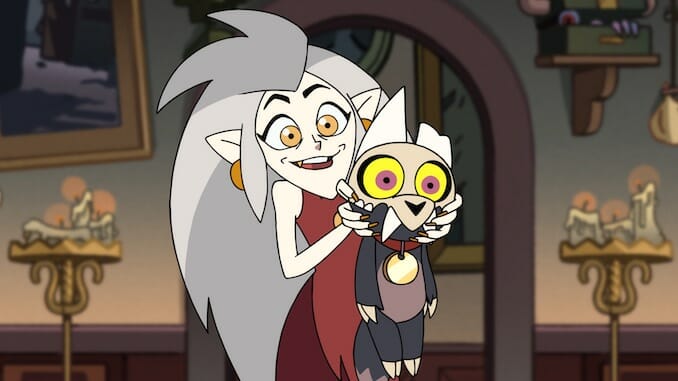Could The Owl House Have Thrived as a Disney+ Original?
Photo Courtesy of The Disney Channel TV Features The Owl House
Disney Channel’s The Owl House was originally planned for a three season story arc, but it’s being cut short. Rather than a full Season 3, it will conclude with three hour-long specials. With fan campaigns asking Disney to make more of The Owl House becoming major Twitter trends, series creator Dana Terrace took to Reddit to explain why the show was canceled.
In the post, Terrace shot down most of the speculated reasons for The Owl House’s cancellation: it wasn’t due to ratings (which she says were good by Disney Channel’s standards); it probably wasn’t due to backlash against the show’s LGBTQ+ representation; it couldn’t be explained by pandemic-era budget restrictions alone. It seems the issue was the opinion of a single executive. “At the end of the day,” Terrace wrote, “there are a few business people who oversee what fits into the Disney brand and one day one of those guys decided TOH didn’t fit that ‘brand.’ The story is serialized (BARELY compared to any average anime lmao), our audience skews older, and that just didn’t fit this one guy’s tastes. That’s it!”
Serialized programming that skews towards a slightly more mature audience, however, is a huge part of the Disney brand, and the backbone of the original programming on Disney+. The Owl House’s serialization wouldn’t be the least bit out of place next to Star Wars: The Bad Batch or Monsters at Work, and it’s nowhere near as mature as the TV-14 What If…? The big difference between The Owl House and Disney+’s animated series so far is that The Owl House is completely original as opposed to a spinoff of a pre-existing IP, yet with the African sci-fi series Iwájú and the Pixar sports comedy Win or Lose in the works, Disney+ clearly isn’t opposed to new stories.
It makes no sense, then, to deem The Owl House a bad fit for the generalized “Disney brand”—it just might be a poor fit for the specific Disney Channel brand. At the Lightbox Expo for animation industry professionals, Disney development executives stated that Disney Channel’s brand is episodic comedy for 6-11 year olds, whereas Disney+ is for “family co-viewing.” In that light, The Owl House feels like a Disney+ show that had bad luck of being pitched a year or two too early and got stuck on the more restrictive cable network.
For what it’s worth, The Owl House seems to be doing well on Disney+, often showing up in the streaming service’s “Trending” selection. Streaming numbers, however, never had a chance of saving the show from cancellation—the decision was made before the first season had even finished airing on Disney Channel and well before the series was added to Disney+.
Cartoons straddling the line between kid-friendliness and adult sophistication have existed as long as animation itself. In the late 2000s and early 2010s, shows like Cartoon Network’s Adventure Time and Steven Universe, Nickelodeon’s Avatar: The Last Airbender and The Legend of Korra, and Disney Channel’s Gravity Falls popularized serialized storytelling in American children’s animation, drawing inspiration from Japanese anime techniques. Today, however, the older kids, teens, and young adults who made such shows hits have by and large abandoned cable for streaming, and as a result, the main kid-focused cable networks have shifted increasing towards focusing on preschool shows and episodic comedy that can easily slot in with reruns.
The Owl House is far from the only cartoon to fall victim to the changing priorities of cable in the age of streaming. OK K.O.! Let’s Be Heroes, created by Steven Universe producer Ian Jones-Quartey, was originally intended to headline Cartoon Network’s section on the then in-the-works HBO Max streaming service, a plan that fell apart due to the Trump administration’s attempts to block the AT&T-Warner Bros. merger. Similar to the situation The Owl House now finds itself in, OK K.O. Season 3 was cut down from a planned 40 quarter-hour episodes to only 20 in 2018, two years before HBO Max would finally launch.
While Ian Jones-Quartey has been open about how the shifting demands of TV and streaming specifically affected his show, he’s also said, “I wasn’t the only casualty of that.” Many speculate that the series Infinity Train struggled similarly; Owen Dennis planned eight story arcs for his anthology series—two aired on Cartoon Network, followed by two more on HBO Max, but the script for a “Book 5” movie was rejected due to focusing on adult characters. Infinity Train was one of HBO Max’s most popular series in 2020, but it seems the show was already doomed by Cartoon Network’s focus shifting away from older-skewing programming.
Despite all of these high-profile cancellations, animation is booming in the streaming world. Netflix has become a particularly expansive home for serialized teen-oriented cartoons like Voltron: Legendary Defender and She-Ra and the Princesses of Power, as well as animated spinoffs for live-action shows like The Witcher. Anime is more popular than ever, thanks to both anime-focused streaming services like Crunchyroll and a wide library on Hulu and elsewhere, not to mention the growing original line-ups on Disney+ and HBO Max that provide plenty of options for animation fans of all ages. Still, it’s unfortunate that great series like The Owl House, OK K.O., and Infinity Train got lost in the transitory shuffle—if they can’t be revived, we can at least hope their creators will find a new home on more welcoming platforms that understand animation can be for everyone.
Reuben Baron is the author of the webcomic Con Job: Revenge of the SamurAlchemist and a regular contributor to CBR and JewishBoston. You can follow him on Twitter at @AndalusianDoge.
For all the latest TV news, reviews, lists and features, follow @Paste_TV.